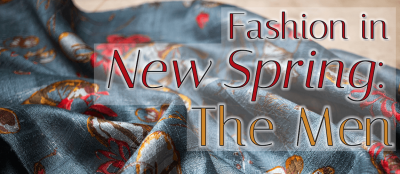Men of the Tower 'New Spring' Fashion
Author: Dar'Jen Ab Owain
Published: January 14 2021 Tar Valon Times Blog
My re-read of the Wheel of Time series began with New Spring. In my previous article I examined the attire of the Aes Sedai. This time around I decided to focus on the men of the Tower of Tar Valon.
The Tower of Tar Valon was home to the Aes Sedai and to the initiates hoping to one day join as full Sisters themselves. “Few people went nearer than a hundred paces unless they had business with the Tower, or wanted to present a petition” (p. 185). Those who did go to the Tower included servants, guardsmen, and Warders.
SERVANTS
The servants of the Tower, men and women, are often referred to as being “liveried” (p. 49). These servants included the cook Laras, in her “long, spotless white apron” (p. 102); workmen, who in the winter would shovel the “path clean two or three times a day if necessary” (p. 58); and “rough-coated grooms” (p. 58). These servants are generally described as having the “white flame of Tar Valon” (p. 36) on their breast.
TOWER GUARDS
The Tower Guards were positioned throughout the Tower Gates. The guardsmen at the gates were “carrying halbreds” (p. 67). The Tower Guards “wore gray steel breast plates over nearly black coats and equally dark cloaks worked with the white teardrop of the Flame of Tar Valon” (p. 59).
Ranks were also distinguishable through the appearance of their uniform. “Seven-striped Tavares over the breast plates marked out bannermen and the lone officer” (p. 59). An under-lieutenant was recognized by “a short white plume” and “face-bars” on his helmet.
WARDERS
An Aes Sedai and her Warder shared a special bond. They could “sense each other’s emotions and physical condition, and each knew exactly where the other was, if they were close enough, and at least a direction if they were far apart” (p. 86). Warders could be found in any of the Ajah’s quarters “excepting the Red, but most kept rooms in the Guard’s barracks or even in the city. Greens’ Warders often lived in the same apartments as the sister!” (p. 115).
Warders were all described as wearing shirts, pants, and boots. Country of origin also influenced the fashion choices of Warders. “One wore silver bells in his dark Arafellin braids, one had a thick Taraboner mustache, and the third was very dark, perhaps a Tairen, or a southern Altaran” (p. 115). Another had a shaved head except for a Shienaran topknot.
Stepin and Karile were Warders to Kerene Nagashi of the Green Ajah. They both had longer hair than their Aes Sedai. There was reference to Stepin buttoning his coat and Karile’s coat having a “capacious coat pocket” (p. 118). Andro was Warder to Meilyn Arganya, who was “one of the few Whites to have a Warder” (p. 84). He was “lean and no taller than his Aes Sedai” and “appeared youthful” (p. 86); and whose eyes “never rested long in one place” (p. 83).
The one article of clothing unique to Warders was their cloak. A Warder’s cloak “was a disconcerting sight” (p. 83). The cloak had the ability to shift colors and blend with what lay behind the Warder. It could make it so that “parts of him and parts of his black gelding seemed not to be there at all” (p. 83). “None wore the distinctive cloak indoors, but the cloak was a mere decoration for a discerning eye” (p. 115).
The fashion of the men within the Tower of Tar Valon was directly determined by their status as a servant, guardsman, or Warder. Servants were identified by the flame of Tar Valon on the breast of their garments. The guardsmen wore the same symbol along with their uniform. The Warders, while they shared the same distinct cloak, had the most opportunity to exhibit their individuality. The country of origin would certainly influence the hair and clothing of these men.
